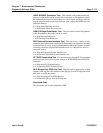
User’s Guide 21020285 D
Chapter 7 Board-control Commands
Unit Options (08H) Page 7 - 21
IAT Inhibit ATN Signal - With this bit you can select whether the adapter
will assert the ATN signal during selection of a target. (Some older SCSI
devices do not respond to the ATN signal and may stop executing commands
if it is asserted.) Setting this bit will prevent the adapter from negotiating for
synchronous transfers, wide transfers, and SCSI-2 features. Parity checking
will also be disabled. If you enable any of these features with this bit set, you
will get errors.
0 ⇒ ATN will be asserted.
1 ⇒ ATN will not be asserted during target selection.
WID Wide Transfers - Either the initiator or the target may introduce
negotiation for wide data transfers. How you set this bit determines whether
the RF3880 adapter will attempt to negotiate with the device. (Even if you do
not set this bit to allow negotiation, if the other device begins negotiation, the
adapter will respond.)
0 ⇒ Do not initiate negotiation for wide data transfer
1 ⇒ Negotiate for wide data transfer.
TAG - The function of this bit varies depending upon whether the adapter is in
initiator or target mode.
Initiator Mode
Tagged Queuing - One of the design options offered with the SCSI-2
specification is the capability to issue multiple simultaneous commands
to each logical unit. If you have a peripheral that is designed to this
specification, you can use this bit to tell the RF3880 adapter to negotiate
for tagged queuing. The tag “type” is specified in the Flags-2 field of
the Pass-through command Parameter Block. Refer to Chapter 5.
0 ⇒ Tagged queuing operation not negotiated.
1 ⇒ Peripheral supports tagged queuing - negotiate for it.
Target Mode
Selection of Group 2 Commands - During Target Mode
operations, the Tag bit controls whether Group 2’s 6- or 10-byte SCSI-2
commands are accepted.
0 ⇒ 6-byte commands accepted; no SCSI-2 devices configured.
1 ⇒ 10-byte commands accepted; SCSI-2 devices configured.
Sense Count
The RF3880 adapter automatically responds to a device Check Condition with
a SCSI Request Sense command. (Unless inhibited on a per command basis
with the IRS bit of the Flags-1 field which is embedded in the SCSI Pass-
through command Parameter Block. See Chapter 5.)
The Request Sense command, issued by the adapter to the device with the
Check Condition, can garner Sense information of up to 256 bytes. The number
returned depends on the number asked for in the SCSI Request Sense command.
The Sense Count field is used to define the number of Sense bytes the adapter
will ask for when automatically issuing a Request Sense command.
Valid values for this field are 0 to 32 (20H).


















